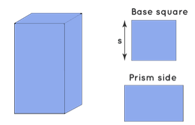About Surface Area of a Square Prism
Let's start with some background information on the issue of square prism surface area. A square prism (right square prism) is a prism with four rectangle-shaped sides and two square bases (one square acts as the top). A square cuboid or square box is another name for it. It's a four-sided prism with equal squares at the base and top and rectangles on the remaining four sides. Both squares are congruent and parallel to one another. The rectangles are also in proportion to one another. Check out the List of Maths Formulas.
What do you mean by Surface Area of a Square Prism?
A square prism's surface area is defined as the total area covered by the surfaces of the prism. A square prism has two square bases and four rectangular sides. A square prism's surface area is measured in square units, such as square metres, square millimetres, square inches, and so on. A square prism, like other three-dimensional forms, has two sorts of regions.
- Total Surface Area (TSA)
- Lateral Surface Area (LSA)
Surface Area of a Square Prism Formula
A square prism's surface area is equal to the sum of the areas of its faces and base. A square prism has the following properties:
- 2 square-shaped bases.
- A rectangle on each of the four side faces.
A square prism's surface area is the sum of the areas of four rectangular side faces and the base area, all of which are squares.
Base Area of a Square Prism
If the length of the square base's side is known, the base area of a square prism can be calculated as follows: Base area of a square prism = Area of base square = s2, where, 's' is the length of the side of the base square.

The base area of the square prism = s2
Square Prism Lateral Surface Area:
If the length of a square side and the height of the prism are known, the lateral surface area can be calculated as follows:
The lateral surface area of a square prism is = Area of the four rectangular sides. The areas of all four rectangles will be equal since they are congruent.
The surface area of the square prism = 4 × (s × h) = 4sh, Here s is the length of the square's side and h is the square prism's height.
Total Surface Area of a Square Prism
If the length of the square's side and the height of the prism are known, the total surface area may be calculated as follows:
The total surface area of a square prism = 2 × Base Area + Lateral Surface Area